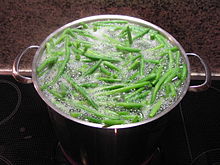Blanching (cooking)
Blanching is a cooking process wherein the food substance, usually a vegetable or fruit, is plunged into boiling water, removed after a brief, timed interval, and finally plunged into iced water or placed under cold running water (shocked) to halt the cooking process. The meaning of blanching is "to whiten", but this is not always the purpose of blanching in cooking. Food is blanched to soften it, or to partly or fully cook it, or to remove a strong taste (for example of bacon, cabbage, or onions).[1] When almonds or pistachios are blanched, the skin of the nut (botanically the seed coat surrounding the embryo) softens and can be easily removed later. The technique of blanching vegetables is best illustrated by the requirement to stop cook asparagus, otherwise it would become soggy due to the asparagus continuing to cook after it is removed from the boiling water. To cook asparagus using the blanching method, the shoots are boiled for 30 seconds, and then to stop further cooking they are dipped into cold or ice water. Note: the term "blanched asparagus" is also used to refer to white asparagus, which is produced by a special gardening technique.

Blanching may simply mean boiling in water for an extended period to remove unpleasant flavours such as tannins. For example, a recommended treatment for African yam bean (Sphenostylis stenocarpa), is dehulling followed by blanching in water for 40 minutes at 100°C.[2] It is recommended that protein-rich salads to be eaten cold (e.g., tuna, turkey, ham, shrimp, lobster, and chicken) are prepared by immersing these protein foods in boiling water for 30 seconds followed by fast chilling.[3] In addition celery, "which is almost always a component of these salads ... should be treated so as to minimize its bacterial content".[3] In the case of French fries, blanching often refers to pre-cooking the French fries in oil at a lower temperature prior to finishing them at a higher temperature. The advantage is that the blanching step cooks the potato. The second step at the higher temperature crisps the outside.[4] In the early 1960s, McDonald's Restaurant in Charlotte, North Carolina, used a process on their potatoes they called 'blanching.' After the potatoes were mechanically peeled and then manually pushed through a slicer producing raw French fries, they were batch-soaked in room-temperature water for 3–5 minutes to remove starch, which they called blanching.[citation needed] Foodstuffs to be blanched are first cleaned, with their scrap and trimmings removed. Vegetables are generally blanched whole, but there are exceptions. Once the product is prepared and is ready to be cooked, it is placed in a large amount of highly saline water that has been brought to a rolling boil. It is preferable to use a good deal of water, as this will prevent it's temperature from dropping too precipitously as the product is added. If the vegetable contains chlorophyll, the cook will monitor the color, generally removing the product and placing it in a bath of ice and cold water. Otherwise, the cooking time is dependent entirely on texture and the desired level of doneness.